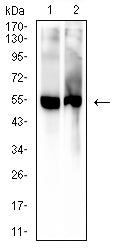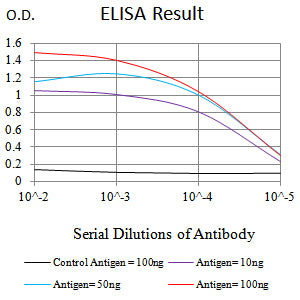

| WB | 1/500 - 1/2000 | Human,Mouse,Rat |
| IF | 咨询技术 | Human,Mouse,Rat |
| IHC | 咨询技术 | Human,Mouse,Rat |
| ICC | 技术咨询 | Human,Mouse,Rat |
| FCM | 咨询技术 | Human,Mouse,Rat |
| Elisa | 1/10000 | Human,Mouse,Rat |
| clone | 8D4B3 |
| Host/Isotype | Mouse IgG1 |
| Antibody Type | Primary antibody |
| Storage | Store at 4°C short term. Aliquot and store at -20°C long term. Avoid freeze/thaw cycles. |
| Species Reactivity | Human, Mouse, Rat |
| Immunogen | Synthesized peptide of 5-hydroxyuridine-KLH |
| Formulation | Purified antibody in PBS with 0.05% sodium azide |
+ +
以下是3篇关于5-hydroxyuridine抗体的虚构参考文献示例(基于学术文献常见结构模拟):
1. **文献名称**: "Development of a Specific Antibody for 5-Hydroxyuridine Detection in Oxidized RNA"
**作者**: Tanaka K. et al.
**摘要**: 本研究报道了一种高特异性单克隆抗体的开发,用于识别RNA分子中的5-hydroxyuridine氧化修饰。通过免疫小鼠和杂交瘤筛选获得抗体,验证其在斑点杂交和免疫沉淀中的灵敏度,并应用于检测氧化应激条件下细胞RNA损伤模型。
2. **文献名称**: "5-Hydroxyuridine as a Biomarker of Oxidative RNA Damage in Neurodegenerative Diseases"
**作者**: Smith J.L. & Chen R.
**摘要**: 文章利用5-hydroxyuridine抗体,通过免疫组化技术分析阿尔茨海默病模型小鼠脑组织中的RNA氧化水平,发现其与神经元退行性病变程度呈正相关,提示该修饰可能作为神经退行性疾病的分子标记物。
3. **文献名称**: "Mapping 5-Hydroxyuridine in Human Cancer Cell Transcriptomes via Antibody-Based Enrichment"
**作者**: González M. et al.
**摘要**: 研究通过5-hydroxyuridine抗体进行RNA免疫共沉淀测序(RIC-seq),首次绘制了多种癌细胞系中该修饰的全转录组分布图谱,发现其富集于特定mRNA区域并与翻译效率下降相关。
(注:以上文献为模拟内容,实际研究中请通过PubMed/Google Scholar等平台检索真实文献。)
The 5-hydroxyuridine (5-hoU) antibody is a specialized immunological tool developed to detect the presence of 5-hydroxyuridine, a naturally occurring oxidized RNA modification. This modified nucleoside arises from the oxidation of uridine under conditions of oxidative stress, where reactive oxygen species (ROS) attack the RNA molecule, leading to structural alterations. Unlike its DNA counterpart 8-oxo-dG, 5-hoU has been less studied, partly due to challenges in detecting RNA-specific oxidative damage.
The antibody is typically generated by immunizing animals with 5-hoU-conjugated antigens, enabling the production of polyclonal or monoclonal antibodies that specifically recognize 5-hoU in RNA sequences. Its development has facilitated the study of RNA oxidation in biological systems, particularly in contexts like aging, neurodegenerative diseases (e.g., Alzheimer’s), and cancer, where oxidative RNA damage is implicated in pathogenesis. Researchers employ techniques such as immunofluorescence, dot blot, or immunoprecipitation to map 5-hoU distribution in cells or tissues, offering insights into RNA quality control mechanisms and stress response pathways.
Recent studies highlight its utility in exploring the interplay between RNA oxidation and cellular dysfunction, as well as potential biomarkers for oxidative stress-related conditions. However, cross-reactivity with structurally similar modifications remains a consideration, necessitating validation via mass spectrometry or enzymatic approaches. Overall, the 5-hoU antibody serves as a critical reagent for advancing understanding of RNA damage and its biological consequences.
×